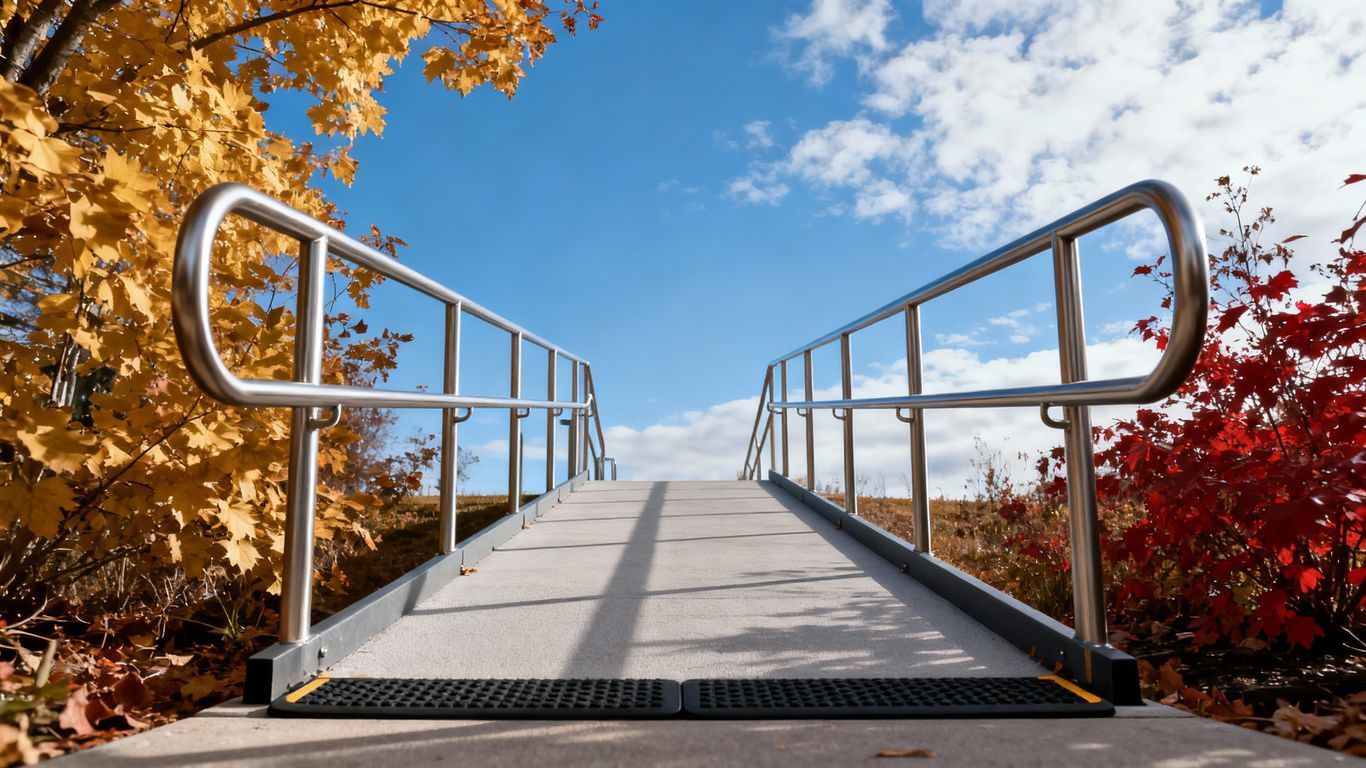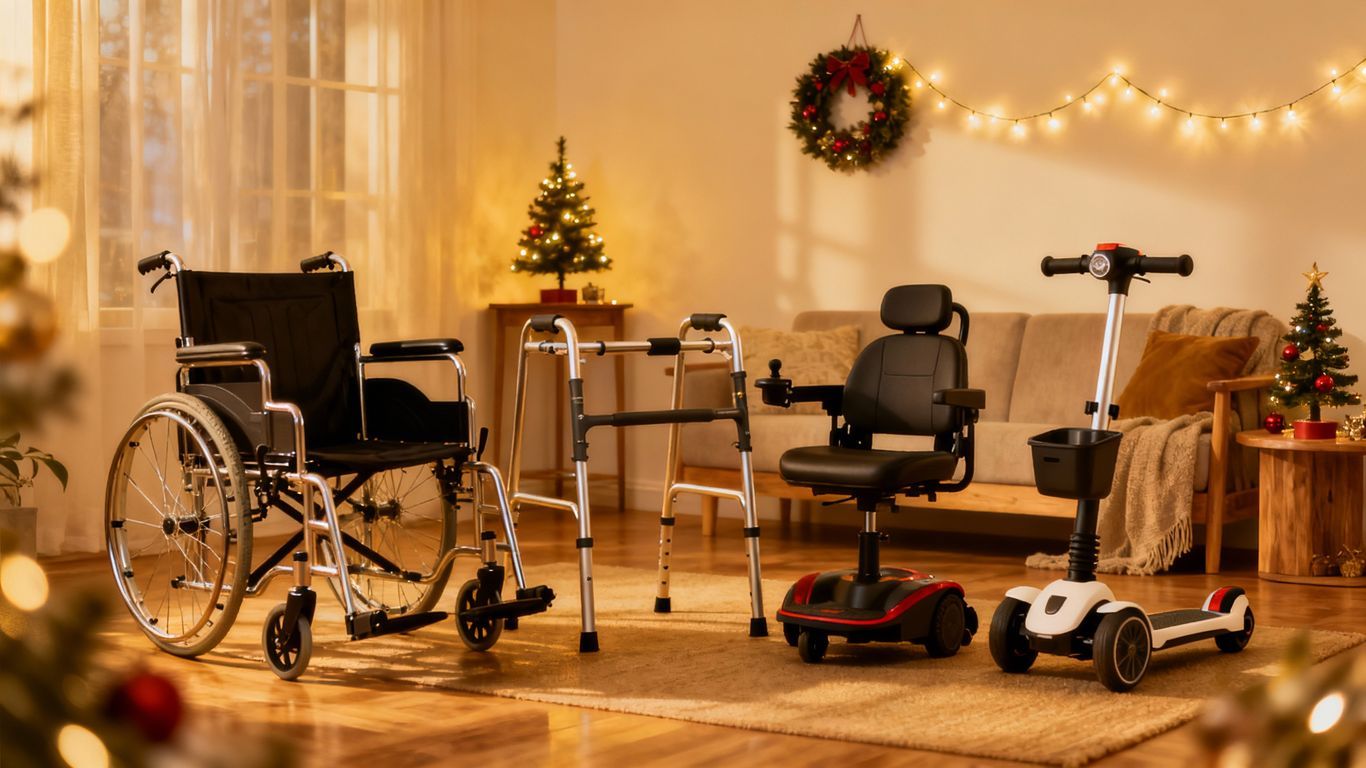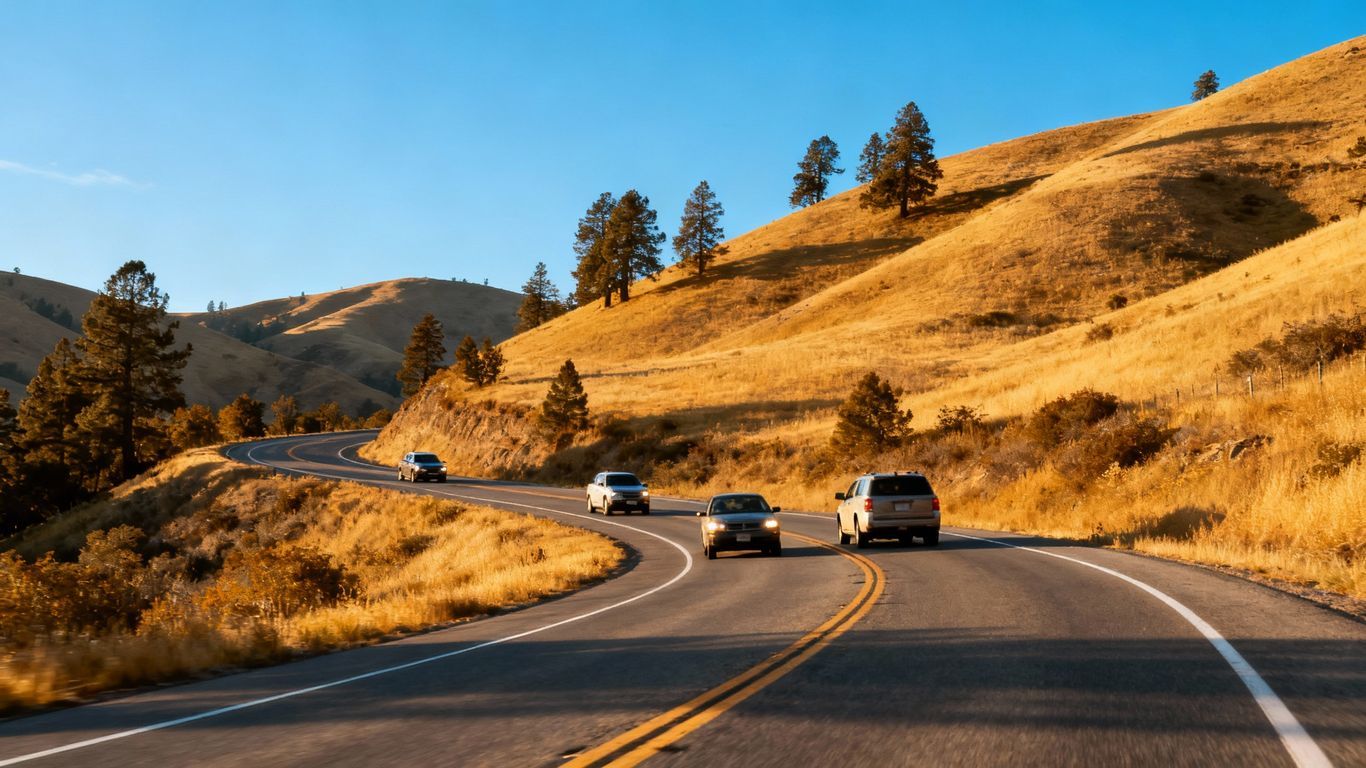November Maintenance Guide for Wheelchair Ramps in Dalton, LaFayette & Surrounding Areas

November is here, and with it comes cooler weather and the potential for winter conditions in Dalton, LaFayette, and the surrounding areas. If you rely on a wheelchair ramp, now's the time to give it some attention. Proper wheelchair ramp maintenance Dalton GA can make a big difference in keeping it safe and usable all season long. Let's look at what you can do to get your ramp ready for whatever the weather throws at us.
Key Takeaways
- Before winter hits, check your ramp for any damage and make sure water can drain away properly. This helps stop ice buildup.
- Regularly look over the ramp's surface, make sure bolts are tight, and the handrails are steady. This is part of good wheelchair ramp maintenance Dalton GA.
- Fix any cracks or worn spots on the ramp surface. Replace parts that are showing wear. Keep metal parts from rusting.
- Clean off leaves and dirt. Wash the ramp and oil any parts that move to keep things working smoothly.
- Make sure the ramp surface isn't slippery, that there's good light, and that the path to and from the ramp is clear.
Preparing Your Wheelchair Ramp For Winter Weather
Winter's coming, and that means dealing with snow and ice. It's easy to forget about your wheelchair ramp when the cold sets in, but it's really important to keep it in good shape. A ramp that's covered in snow or ice can be a real hazard, making it difficult or even impossible for someone to get around. So, let's talk about how to get your ramp ready for whatever the North Georgia weather throws at it.
Clearing Snow and Ice
This is probably the most obvious part, but it's worth going over. You don't want a thick layer of snow or a sheet of ice making your ramp unusable. Here’s a quick rundown:
- Shovel early and often: Don't wait for a blizzard to pile up. Try to clear snow as soon as it falls, especially if you know someone needs to use the ramp soon.
- Use the right tools: A sturdy shovel is a must. For ice, consider using a de-icer that's safe for your ramp's material. Avoid sharp tools that could scratch or damage the surface.
- Be mindful of salt: While salt can melt ice, some types can damage certain ramp materials over time. Check what's recommended for your ramp type.
Checking For Structural Integrity
Winter weather can be tough on structures. Freezing and thawing cycles can put stress on materials, and heavy snow can add weight. It’s a good idea to give your ramp a good look-over before the worst weather hits.
- Look for cracks or splits: Especially in wood or composite ramps, check for any new damage that might have appeared over the year.
- Inspect connections: Make sure bolts, screws, and other fasteners are still tight. Loose connections can become bigger problems when stressed by ice and snow.
- Check for sagging: If the ramp looks like it's dipping in the middle, that's a sign it might not be able to handle heavy snow loads.
Ensuring Proper Drainage
Water is the enemy when it comes to freezing temperatures. If water can't drain away from your ramp, it can freeze, expand, and cause damage. Plus, standing water can turn into slippery ice.
- Clear drain holes: If your ramp has specific drainage holes, make sure they aren't blocked by leaves, dirt, or debris.
- Check the surrounding area: Ensure that water from the ground around the ramp has a clear path to flow away and isn't pooling at the base.
Keeping your ramp clear and in good shape before winter really makes a difference. It's not just about convenience; it's about safety and making sure everyone can get where they need to go, no matter the weather. A little bit of prep work now can save a lot of trouble down the road.
Routine Inspections For Wheelchair Ramps Dalton GA
Hey folks, let's talk about keeping those wheelchair ramps in good shape, especially here around Dalton. It's not just about making things look nice; it's about safety and making sure everyone can get around without a hitch. Regular checks are super important, and honestly, they don't take too much time.
Surface Condition Checks
First off, take a good look at the ramp's surface. You want to make sure it's not getting too worn down. Things like cracks, splintering wood, or uneven patches can be tripping hazards or make it hard for wheels to roll smoothly. A smooth, even surface is key for easy navigation. Check for any loose bits or areas that feel soft or spongy, which could mean rot or damage underneath. It’s also a good time to think about what kind of ramp is best for your home in North Georgia; there are some great wheelchair ramp options available.
Fastener Security
Next up, let's talk about how everything is held together. Bolts, screws, and any other fasteners need to be tight. Over time, vibrations from use and weather can loosen them up. A loose ramp section isn't just annoying; it's a real safety risk. Give everything a good wiggle and tighten up anything that feels loose. You don't want any parts of the ramp shifting unexpectedly.
Handrail Stability
And finally, the handrails. These are there for support, so they absolutely need to be solid. Grab onto them and give them a good push and pull. Do they feel sturdy? Is there any wobble? If a handrail feels loose or shaky, it's a clear sign that it needs attention right away. People rely on these for balance, and a weak handrail can lead to falls.
Keeping up with these routine checks means you're less likely to run into bigger, more expensive problems down the road. It's all about proactive care for accessibility equipment.
Addressing Wear And Tear On Accessibility Ramps
Over time, even the sturdiest wheelchair ramps can start to show their age. Little things can become big problems if you don't keep an eye on them. Regular checks for wear and tear are just as important as clearing snow. It's about keeping things safe and usable, day in and day out.
Repairing Surface Damage
Look closely at the ramp's surface. Are there any cracks, chips, or areas where the material seems to be breaking down? These aren't just unsightly; they can create tripping hazards or make it harder for wheels to roll smoothly. Small issues, like a loose board or a minor crack, are usually pretty straightforward to fix. You might be able to patch them up yourself with the right materials, or a quick call to a local handyman could sort it out.
Replacing Worn Components
Sometimes, it's not just the surface that needs attention. Think about the parts that get a lot of use. This could include:
- Fasteners: Bolts, screws, and other connectors can loosen or rust over time. Make sure they're tight and not showing signs of decay.
- Edge Guards: If your ramp has edge guards, check that they're still firmly attached and haven't become loose or broken.
- Decking Material: If the ramp is made of wood, individual planks might need replacing if they become rotten or splintered.
Preventing Rust and Corrosion
Metal ramps, or ramps with metal components, are especially prone to rust, particularly with the damp weather we get around here. Rust doesn't just look bad; it weakens the metal, making it less safe. A good way to fight this is with regular cleaning and, if needed, a fresh coat of rust-inhibiting paint or sealant. For any moving parts, like hinges or gate mechanisms, a bit of lubrication can go a long way in preventing stiffness and rust.
Keeping your ramp in good shape means thinking ahead. A little bit of work now can save you a lot of trouble, and expense, down the road. It's all about making sure the ramp continues to be a reliable pathway for everyone who needs it.
Don't wait until a small problem becomes a major repair. Addressing wear and tear promptly is key to maintaining a safe and functional accessibility ramp.
Seasonal Cleaning For Optimal Ramp Performance
Keeping your wheelchair ramp clean isn't just about looks; it's a big part of making sure it works right and stays safe, especially as the seasons change. Think of it like giving your car an oil change – it just needs regular attention to keep running smoothly. A clean ramp is a safer ramp.
Debris Removal
First things first, you've got to get rid of all the gunk that accumulates. This means leaves, dirt, twigs, and whatever else the wind decides to deposit.
- Fall Cleanup: After the leaves have mostly fallen, do a thorough sweep. Pay attention to corners and edges where debris likes to hide.
- Spring Clearing: Once the snow melts, you'll likely find mud and sand. Get that cleared off before it gets ground into the surface.
- Regular Checks: Even between seasons, a quick look every week or two can catch small messes before they become big problems.
Washing And Rinsing
Once the loose stuff is gone, a good wash makes a difference. This helps remove grime that sweeping alone won't get.
- Use a mild soap and water. Avoid harsh chemicals that could damage the ramp material.
- A stiff brush can help scrub away stubborn dirt or mildew.
- Rinse thoroughly to get all the soap residue off. Leftover soap can make the surface slippery.
Keeping your ramp clean helps prevent materials from breaking down over time. It's a simple step that adds years to its life and keeps it looking good.
Lubricating Moving Parts
If your ramp has any moving parts, like hinges or folding mechanisms, they need a little love too. This is often overlooked, but it's important for smooth operation. A little bit of lubricant can stop squeaks and make folding or unfolding much easier. For more involved accessibility needs, you might want to look into local specialists who can help with a full assessment of your system, like North Georgia Mobility.
- Identify all moving parts.
- Apply a suitable lubricant (check your ramp's manual if you have one).
- Work the parts back and forth to spread the lubricant evenly.
Doing this cleaning and maintenance regularly means your ramp will be ready for whatever the weather throws at it, and more importantly, it will be a reliable and safe pathway for anyone who needs it.
Safety Considerations For Wheelchair Ramps
Keeping your wheelchair ramp safe is a big deal, especially with winter weather rolling in. It’s not just about making it easy to get around; it’s about preventing accidents. A well-maintained ramp is a safe ramp.
Maintaining Non-Slip Surfaces
This is probably the most important part. You don't want anyone slipping, right? Especially when it's wet or icy out. Here’s what to look out for:
- Surface Texture: Make sure the ramp surface itself has good grip. If it feels slick, even when dry, it might be time to look into adding some non-slip coatings or strips. We found some good info on proper ramp installation that touches on this.
- Ice and Snow: During colder months, ice and snow can make any surface treacherous. Keep a close eye on this and clear it promptly. Using a safe de-icer is a good idea, but avoid harsh chemicals that could damage the ramp material.
- Wear and Tear: Over time, the non-slip features can wear down. Regularly check for smooth spots or areas where the grip is gone.
Keeping the ramp surface in good shape means thinking about how water flows off it. If water pools up, it can freeze and create a slippery hazard. Good drainage helps keep the surface dry and safer.
Ensuring Adequate Lighting
Can you see where you're going? It sounds simple, but poor lighting is a common hazard. This is especially true if the ramp is used after dark or in dimly lit areas. Think about:
- Ambient Light: Is there enough natural light reaching the ramp during the day?
- Artificial Light: Consider installing motion-sensor lights or low-level pathway lighting along the ramp. This makes a huge difference.
- Bulb Checks: If you have lights, make sure the bulbs are working and replace them as needed. It’s easy to forget about a burnt-out bulb.
Clear Access and Egress
This means making sure there's a clear path to and from the ramp. No one wants to struggle to get to the ramp or find an obstacle waiting at the end.
- Obstruction-Free Zones: Keep the areas at the top and bottom of the ramp clear of anything that could block passage. This includes things like planters, trash cans, or even parked bikes.
- Landing Areas: The landings at the top and bottom should be spacious enough for maneuvering a wheelchair or walker. They need to be clear and level.
- Pathways: The walkways leading to and from the ramp should also be kept clear of debris, snow, or ice. This ensures a smooth transition onto the ramp itself.
Professional Assessment Of Your Ramp System
When To Call An Expert
Sometimes, you just know when a job is bigger than you can handle. For wheelchair ramps, this often happens after a particularly rough winter or if you notice a significant change in how the ramp feels or looks. If you're seeing cracks that seem to be getting bigger, if the ramp feels wobbly, or if water isn't draining away like it used to, it's probably time to get a professional opinion. Don't wait for a small problem to become a big safety hazard. It's better to be safe than sorry, especially when it comes to accessibility equipment.
Benefits Of Professional Maintenance
Getting a pro to look at your ramp can save you a lot of headaches down the line. They have the experience to spot issues you might miss. Plus, they know the local building codes and accessibility standards, so they can tell you if your ramp is up to par. Regular check-ups can also extend the life of your ramp, saving you money on premature replacements. It's like taking your car in for an oil change – it keeps things running smoothly and prevents costly breakdowns.
Here’s what a professional assessment typically covers:
- Structural Check: They'll look at the main supports, connections, and overall stability.
- Surface Evaluation: Checking for wear, loose boards, or damage that could cause trips.
- Drainage System Review: Making sure water can get away from the ramp and its foundation.
- Handrail and Fastener Inspection: Confirming everything is secure and in good working order.
Finding Local Accessibility Specialists
Finding someone reliable in the Dalton, LaFayette, and surrounding areas isn't too hard. Start by asking friends or neighbors who have had ramps installed or serviced. Local disability advocacy groups can also be a good resource for recommendations. You can also search online for companies that specialize in accessibility modifications or mobility equipment. Look for businesses that have been around for a while and have good reviews. It’s a good idea to get a few quotes before you decide on someone.
When you're looking for help with your ramp, remember that accessibility is about more than just having a ramp; it's about having a safe and reliable ramp that truly makes life easier. A professional can help you achieve that peace of mind.
We can check out your ramp system to make sure it's working just right. Our team will look it over and give you the lowdown on how it's doing. If you want to know more about how we can help, check out our website!
Wrapping Up Your Ramp Care
So, that's the rundown on keeping your wheelchair ramps in good shape this November around Dalton and LaFayette. It might seem like a lot, but a little bit of attention now can save you headaches later. If you're finding yourself needing more help or thinking about upgrades, remember North Georgia Mobility. They've been around for ages, helping folks out with all sorts of accessibility stuff. Give them a shout if you have questions or need a hand with anything ramp-related or other home changes. Taking care of these things means more freedom for everyone.
Frequently Asked Questions
Why is it important to get my wheelchair ramp ready for winter?
Getting your ramp ready for winter is super important because snow and ice can make it slippery and dangerous. Also, the cold weather can sometimes weaken the ramp's parts. Taking care of it now means it will be safe and easy to use all winter long, so you don't have to worry about slips or falls.
How often should I check my wheelchair ramp?
It's a good idea to give your ramp a good look-over at least once a month. You should also check it after big weather events, like heavy rain or snowstorms. Quick checks help you spot any small problems before they become big, costly repairs.
What should I do if I see damage on my ramp's surface?
If you notice cracks, holes, or rough spots on your ramp's surface, it's best to fix them right away. Small damages can get worse over time, especially with weather changes. Depending on the material, you might be able to patch it up yourself, or you might need to call someone who specializes in ramp repairs.
How can I keep my ramp from getting rusty?
To stop rust, especially on metal ramps, make sure to keep them clean and dry. You can also use a rust-preventing spray or paint. Checking for any chipped paint and touching it up quickly helps create a protective barrier against moisture.
What's the best way to clean my wheelchair ramp?
Cleaning is pretty straightforward. First, clear off any leaves, dirt, or other stuff that's piled up. Then, wash it down with mild soap and water. Make sure to rinse it well and let it dry completely. For ramps with moving parts, like hinges, a little bit of lubrication can help them work smoothly.
When should I think about calling a professional for ramp help?
You should call a professional if you notice any major structural issues, like wobbly supports or loose railings that you can't fix yourself. Also, if you're unsure about how to repair something or if the ramp has significant damage, it's safer to get an expert's opinion. They have the tools and know-how to ensure your ramp is safe and up to code.










